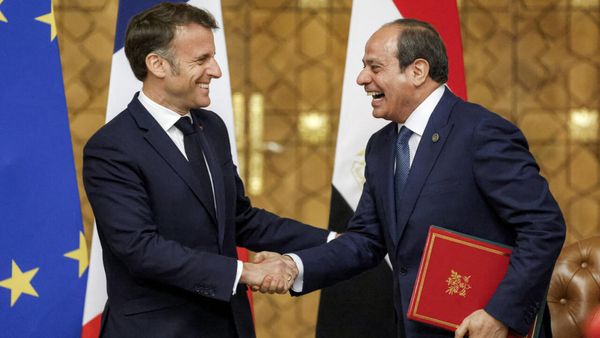
Relationships mean everything on Wall Street, and perhaps nowhere has this been more obvious than Goldman Sachs’s quarter-century-long journey with Juniper Networks.
In January, Juniper, once one of the hottest startups and which helped revolutionize the networking space, agreed to sell itself to Hewlett Packard Enterprise for $14 billion. Juniper CEO Rami Rahim, who started with the company about 28 years ago, will lead the new HPE networking business and report to Antonio Neri, HPE’s president and CEO. It’s unclear how many of Juniper’s 11,000 employees are joining HPE or whether Juniper will keep its name. HPE, according to a spokeswoman, will evaluate team structures and needs throughout the integration process and decide on branding after the deal closes.
The deal is a bittersweet ending for Goldman, which has advised Juniper for 25 years, including its sale to HPE. “It’s like birth and death,” one Goldman exec told Fortune. “The IPO and the sale are bookends of the company’s life. On one hand, the deal is very innovative and high profile. On other hand, the company Juniper goes away.”
Goldman has advised some of the biggest companies—Apple, Microsoft, Tesla, and Nvidia among them—but with Juniper, the storied investment bank was there at the very beginning, in 1999, with the dot.com boom in high gear. Investors were pouring millions of dollars into unprofitable web startups, many of which went public and saw their stock prices double—or even triple—in their debuts.
Pradeep Sindhu, a pioneering computer scientist, in 1996 cofounded Juniper, which made the Internet routers that were used by some of the biggest service providers of that time, including UUNet, an MCI WorldCom company; Cable & Wireless USA; and AT&T. Juniper raised millions from some of the biggest venture firms of the late 1990s, like Kleiner Perkins and New Enterprise Associates, meanwhile Goldman was a top IPO banker, having served as the lead underwriter on some of that era’s biggest IPOs, including Yahoo, Red Hat, and Expedia.
To win the mandate for the Juniper IPO, Goldman had to compete against several other firms, including Credit Suisse, or CSFB, the top underwriter of new issues from 1999 to 2000, Fortune has reported. About a dozen Goldman bankers, including a number of partners, worked on the team that pursued Juniper, said the executive, who added: “It was a massive gang tackle.”
First, Goldman had to solve a big problem: Juniper didn’t want its shares to rise during the IPO and then have them plunge once insiders began off-loading them when the 180-day lock-up expired. Goldman came up with the “staggered lockup,” an innovation that allows insiders to sell a percentage of their shares in phases, avoiding the volatility often seen when large blocks are sold all at once.
“Staggered lockups have become more common over time. Back then, 180 days for everybody was pretty standard,” said Jay Ritter, a finance professor at the University of Florida’s Warrington College of Business, who pointed to Google’s 2004 IPO.
The lockup innovation helped Goldman win over Juniper and become lead underwriter, the most coveted position a bank can hold in an IPO. In June 1999, Juniper became a dot.com darling when its stock soared 190% from its $34 offer price on its debut. (The Juniper IPO occurred one month after Goldman went public.)
'A crazy time'
Juniper certainly was “a hot IPO” in 1999, but it ended up ranking just 53rd out of 486 that year, noted Matt Kennedy, senior IPO strategist at Renaissance Capital, a provider of pre-IPO research that manages two IPO-focused ETFs. “I think that tells you how much of a crazy time the Internet bubble was.”
Of the 17 banks listed in Juniper’s S-1 regulatory filing, roughly seven still exist. Since then, Goldman has remained in constant dialogue with Juniper, cementing its status as one of the company’s most trusted advisors. Over 100 people, including some of the biggest names at Goldman, have worked on deals for Juniper, including: Stephen Pierce, currently chairman of global equity capital markets; Cindy Panchula, chief of staff for global TMT banking; Ryan Limaye, co-head of global technology investment banking; Pawan Tewari, co-head of technology M&A; John Waldron, president and COO; and Dan Dees, co-head of global banking and markets. (Dees led a $1.4 billion block trade of Juniper stock that was owned by Ericsson in 2000.)
In the early 2000s, Juniper wanted to expand into the edge router market and was in negotiations to buy an unnamed company, but due diligence revealed some concerns. Juniper decided not to do the deal, the Goldman executive told Fortune. Instead, Goldman advised Juniper to target Unisphere Networks, which was rumored to be considering an IPO. Juniper acquired Unisphere in 2002, expanding its niche in edge routers. (Jim Dolce, Unisphere’s CEO, has served on Juniper’s board since 2015.) In 2004, Goldman advised Juniper when it scooped up Netscreen Technologies for $4 billion. Netscreen, a leader in firewalls, was part of Juniper’s effort to increase its security capabilities.
Juniper had to fend off activist investors buying up shares in 2013, and Goldman was there, too. The bank contacted Robyn Denholm, then Juniper’s CFO, and warned that “something might be coming,” the person said. Denholm, who’s now chairman of Tesla’s board, agreed that Juniper needed to prepare itself. It turned out that Elliot Management had built up a sizable position, 6.2%, and wanted to make changes at Juniper, including a stock buyback and cost reductions of $200 million.
“Elliot was pushing them to break the company up, which didn’t make sense,” the person said. Juniper negotiated a settlement with Elliot in February 2014 in which it agreed to add directors, cut $160 million in costs, and commit to a $3 billion capital return. The next year, Juniper added two more directors that Elliot supported. “It was a two-year dialogue with Elliot over their demands,” the person said.
Goldman has advised four different Juniper CEOs. Sometimes the leaders don’t have a relationship with the bank, or may be loyal to another bank, but Goldman has remained a key advisor. The secret to a long, durable relationship is to put the client’s interest first, the exec told Fortune. “If you do that with regularity, and sufficiently, they will feel that you are a trusted advisor. Hopefully, they will select you when they need someone.”
It was fitting that Goldman was on stage for Juniper’s last act. The networking space has slowed considerably since the late 1990s, while software, the internet, and AI have skyrocketed. Juniper has posted modest sales growth for many years, although its stock price never again reached its dot.com boom highs.
Still, it was HPE that first approached Rahim, Juniper’s CEO, about a potential transaction in February 2023, initially offering $37.75 a share—a figure that rose to $40 after months of negotiations, according to a Feb. 7 proxy filing. Ultimately, it was an offer Juniper couldn’t turn down. “Companies often don’t choose to sell,” the exec said.







